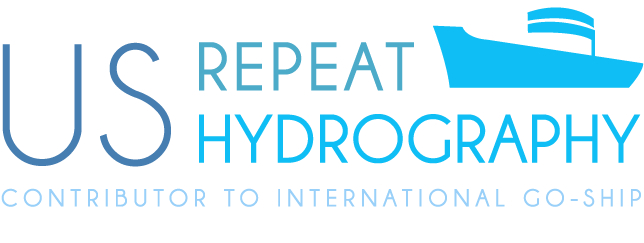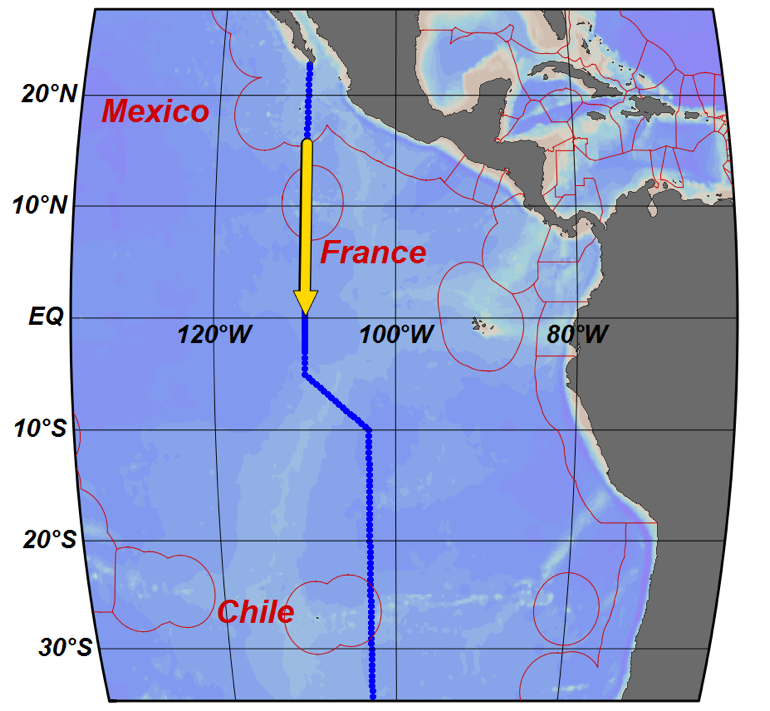
14 December 2016
Prepared by Brendan Carter 12/05/2016

A map of our section, with the yellow arrow highlighting what we’ve done this week. We have now emerged from the French and Mexican EEZs (red circles) with a complete set of measurements from each region. French? In the middle of that circle we passed through is a small island claimed by France named Clipperton. It is still the closest land to us.
It has been a pretty good week. We’ve hit our stride, and have begun completing our station work quickly and efficiently. We did 29 stations across 13.5° between Nov 28th and Dec 5th. The Brown has been averaging more than 10.5 kts between stations, our team is sending the CTD-sensor rosette package down to 10 meters off the ocean floor and bringing it back filled with water as quickly as we’d hoped, and we’ve had calm weather and no additional major delays. Our quick pace perhaps feels faster still due to the ~3700 m average depth of the stations, which is a bit shallower than many of our veteran repeat hydrographers are used to. We are testing the throughput of our teams various analytical systems despite using a 24 position rosette (vs. the 36 position rosettes that bring back 150% as much seawater).
Our pace southward has slowed somewhat in the last day as we’ve hit the high-resolution equatorial stations. We’ve doubled the resolution from one station per 30 nautical miles to one per 15 nautical miles within a ±3° window of the equator. This is to capture the unique mixing, currents, and upwelling found in this narrow band where the influence of the Coriolis force—one of the major factors that governs the movement of water throughout the ocean— effectively vanishes. The Brown has slowed, but samples are coming aboard more quickly than ever. This is crunch time for samplers on leg 1, and we’re looking forward to a return to normalcy in 4° south/3 days. We’ll cross the equator Tuesday around dinner.
Impacts of delays
Our schedule for this cruise has been in flux since early October due to our various delays, but we’ve finally settled on port dates for arriving in Easter Island: Dec. 24th, Christmas Eve. Leg 2 will depart on the 28th. We are glad to be able to begin booking flights and planning our time on Easter Island. Leg 2 should arrive back in Punta Arenas within the first two days in February, 2017.
In light of the delays, we have opted to reduce our double resolution equatorial stations from a ±5° to a ±3° band around the equator. Also, we are no longer planning any station work on the P17extension that connects the P18 line to Chile. The increased need for efficiency has decreased our tolerance for delays. Typically, infrequent short delays can provide the valuable service of allowing our analysts time to collect and analyze more samples per station, especially in high-resolution sampling regions like the equator. An increased need for efficient progress south may therefore translate into a less-complete record of the seawater brought aboard. Bongo net casts had been planned to take place during such brief delays, but with the need for efficiency the bongo net program was planned to be scaled back. (Later the bongo tows were cancelled entirely, see below.) Similarly, Charles Kovach—our scientist making measurements of the optical properties of seawater who is constrained as to when he can do his measurements by cloud-cover and the timing of satellite overpasses—is now also limited to conducting his work when we are already on station. In short, the delays have made things harder for most scientists and forced us to be slightly less ambitious.

A section of temperature against depth with contours for dissolved O2 in μmol kg−1. Profiles go to the ocean floor. Dots indicate where seawater samples were collected for discrete analyses. Grey areas represent the ocean floor as it is represented in a low resolution data set.
Continued science
Aside from fallout from the delays our scientific programs are going as planned. Our teams are still building up and combing through a wealth of calibration and assessment data. Samples are piling up for shore-side analysis, and data is beginning to pour into our data files through the hard work of our shipboard analysts and our data manager, Remy Okazaki. The new (or rather updated) data submission and management software developed by John Bullister is working well for us, which is wonderful because Remy has also absorbed much of the work of the scientists we lost to the delays leaving port (e.g. see the picture below).
The aft winch
As mentioned in the previous report, the aft winch began spooling out in an uncontrolled fashion toward the end of last week. Our quick-thinking winch drivers saved the package by applying a failsafe break, and our team was able to retrieve the CTD-sensor package intact. Troubleshooting is ongoing and the Brown’s engineers have ordered several parts for Easter Island that we hope will make the aft winch whole again in time for leg 2. In the meantime, we’ve been using the forward winch. While fully functional, the forward winch comes with the added difficulty that it is situated a bit further forward of the tracks we use to move the package in and out of the staging bay. We’re therefore using a “tugger” or a pneumatic rope-winch, to reposition the package before landing it on the platform. This is adding a bit more work and a lot more excitement to retrievals. This strategy is working great for now, but we hope to have a better way of doing retrievals before the project moves into the nearly-permanent winds and high seas of the Southern Ocean (i.e. before leg 2).
 Jay Hooper (left) and Remy Okazaki (middle) using the “tugger” to get the package safely onto the rails from the forward winch.
Jay Hooper (left) and Remy Okazaki (middle) using the “tugger” to get the package safely onto the rails from the forward winch.The bongo nets need to be deployed on a different wire than the CTD-sensor package. They had previously been deployed off the forward winch. However, with the aft winch not working and the CTD having been moved to the forward winch, the bongo tows have now been put on hold entirely. In retrospect, it is perhaps fortunate for Javier (our sole bongo specialist) that the delays prevented him from joining us.
Aft winch silver lining: a complete sensor package
During a brief downtime while the aft winch was being actively troubleshot, our CTD team swapped out the CTD for a spare, and we now have a fully functional package with primary and secondary sensors for conductivity, temperature, pressure, and dissolved oxygen, as well as a reference temperature sensor and sensors measuring optical transmittance, backscatter, and fluorescence.
Summary
We’re making good time and assessing the impact of the many delays to date. We’re digging in for a long cruise, and we are hoping for continued efficient southward progress toward Easter Island. That port date remains distant, but at least it is now solid.